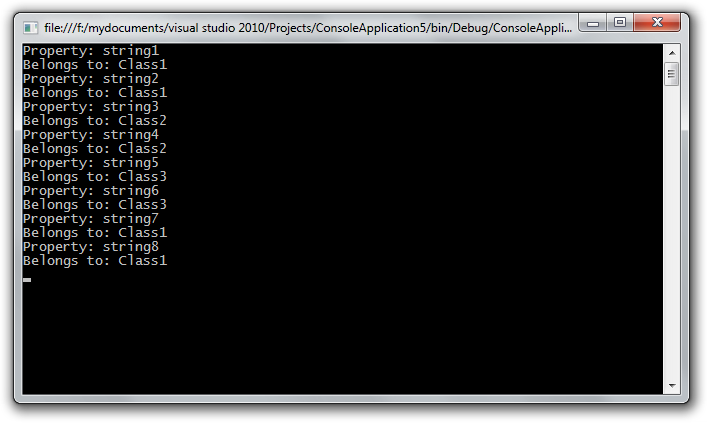Introduction
In part one of reading the sourcefile with Roslyn I installed Roslyn, made a new console project and read the content of this file. Now lets go a bit further.
Property and class
So I adapted my sourcefile to contain a bit more posibilities.
Public Class Class1
Public Property string1 As String
Public Property string2 As String
Private Class Class2
Public Property string3 As String
Public Property string4 As String
End Class
End Class
Public Class Class3
Public Property string5 As String
Public Property string6 As String
End Class
Partial Public Class Class1
Public Property string7 As String
Public Property string8 As String
End Class
If I now run my previous example.
Imports System.IO
Module Module1
Sub Main()
Dim sourcetext As String
Using streamReader = New StreamReader("F:MyDocumentsVisual Studio 2010ProjectsConsoleApplication5Class1.vb")
sourcetext = streamReader.ReadToEnd
End Using
For Each prop In SyntaxTree.ParseCompilationUnit(sourcetext).Root.DescendentNodes.OfType(Of PropertyStatementSyntax)()
Console.WriteLine(prop.GetText)
Console.WriteLine(prop.Identifier.GetFullText)
Next
Console.ReadLine()
End Sub
End Module```
I get the following result.
<div class="image_block">
<a href="https://lessthandot.z19.web.core.windows.net/wp-content/uploads/users/chrissie1/roslyn/roslyn3.png?mtime=1319311151"><img alt="" src="https://lessthandot.z19.web.core.windows.net/wp-content/uploads/users/chrissie1/roslyn/roslyn3.png?mtime=1319311151" width="707" height="423" /></a>
</div>
That is not a very usefull result since I have no idea where the properties are coming from. But that is easliy fixed since each property also has a parent property.
```vbnet
Imports System.IO
Module Module1
Sub Main()
Dim sourcetext As String
Using streamReader = New StreamReader("F:MyDocumentsVisual Studio 2010ProjectsConsoleApplication5Class1.vb")
sourcetext = streamReader.ReadToEnd
End Using
For Each prop In SyntaxTree.ParseCompilationUnit(sourcetext).Root.DescendentNodes.OfType(Of PropertyStatementSyntax)()
Console.WriteLine("Property: " & prop.Identifier.GetText)
If TypeOf prop.Parent Is ClassBlockSyntax Then
Console.WriteLine("Belongs to: " & CType(CType(prop.Parent, ClassBlockSyntax).ChildNodes(0), ClassStatementSyntax).Identifier.GetText)
End If
Next
Console.ReadLine()
End Sub
End Module
Which gives this result.
You have to watch out because the parent is not a ClassStatementSyntax but a ClassBlockSyntax. The ClassBlockSyntax does not contain the identifier but it does contain a childnode that is a ClassStatemetSyntax which does contain the identifier. You could just print the whole syntaxtree to find this out, or RTFM.
Of course you can also use a bit more LINQ and get this.
Option Strict Off
Imports System.IO
Module Module1
Sub Main()
Dim sourcetext As String
Using streamReader = New StreamReader("F:MyDocumentsVisual Studio 2010ProjectsConsoleApplication5Class1.vb")
sourcetext = streamReader.ReadToEnd
End Using
Dim propclasses = From e In SyntaxTree.ParseCompilationUnit(sourcetext).Root.DescendentNodes.OfType(Of PropertyStatementSyntax)() Select New With {.PropertyName = e.Identifier.GetText, .ClassName = CType(CType(e.Parent, ClassBlockSyntax).ChildNodes(0), ClassStatementSyntax).Identifier.GetText}
For Each propclass In propclasses.OrderBy(Function(x) x.ClassName)
Console.WriteLine("Property: " & propclass.PropertyName)
Console.WriteLine("Belongs to: " & propclass.ClassName)
Next
Console.ReadLine()
End Sub
End Module
With a slightly different result as before.
Conclusion
Once you got how the syntaxtree thing works it’s very easy to find what you need.






 Chris is awesome.
Chris is awesome.